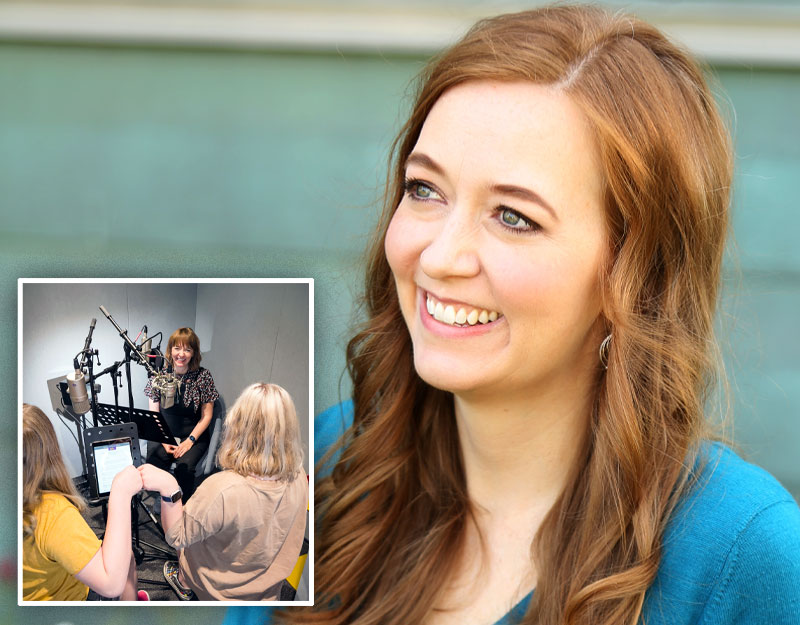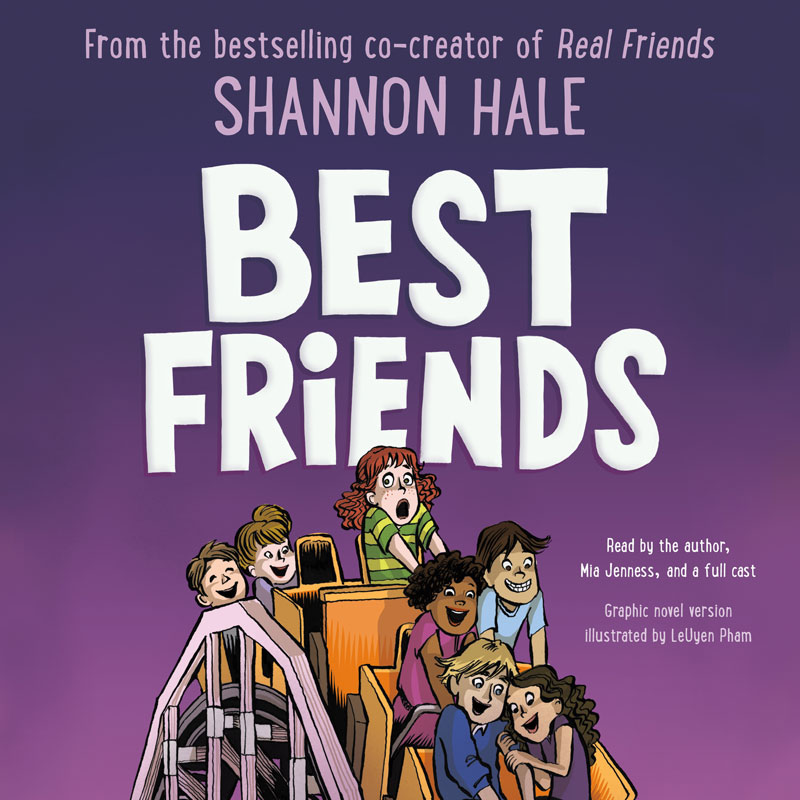Shannon Hale on Adapting Middle Grade Graphic Novel "Best Friends" as an Audiobook
In this guest post, author Shannon Hale discusses adapting her graphic novel Best Friends as an audiobook, with a behind-the-scenes look at how she wrote the script and took part in the narration.
 |
Photo by Jenn Florence. Inset photo: "Behind the scenes" courtesy of Abigail Starr. |
In this guest post, author Shannon Hale discusses adapting her graphic novel Best Friends as an audiobook, with a behind-the-scenes look at how she wrote the script and took part in the narration.
An audiobook edition of a graphic novel? This might not seem like an obvious choice, and certainly was a first for me, but it’s one in a long string of firsts and unobvious choices.
In 2004, after publishing two fantasy novels, I told my editor that I was interested in writing a graphic novel. At that time, I had to explain to most people what a graphic novel even was (“graphic refers to the pictures, not any adult and violent content"). But my husband became a reader almost solely due to comic books, and I was meeting many kids who weren’t up to reading novels. Kids who are primarily visual learners were being left out.
Along with Nathan Hale, my husband, Dean Hale, and I created Rapunzel’s Revenge , and since then I’ve published seven more graphic novels. It’s thrilling to witness how revolutionary this format of books has become in so many readers’ lives.

In 2014, I began to write Real Friends, a graphic novel memoir about elementary school. Memoir was another unexpected first for me. My childhood hadn’t been particularly extraordinary, surely not worth writing a whole book about. Throughout the process, the running commentary in my brain screamed “SHUT UP, SHANNON, NOBODY CARES THAT SOMEBODY WAS MEAN TO YOU IN FOURTH GRADE!” Our thoughts can be so helpful. But much to the surprise of my anxiety brain, immediately after publication, I began hearing from many readers that Real Friends helped them feel seen and understood in their own non-extraordinary, and still very challenging, elementary school years. Real Friends was rewarding but also difficult to create, and I was hesitant to jump back into the morass of memoir, but I had more to say about sixth grade, which is an often-turbulent transitional age.
In Best Friends, I told the truth of what sixth grade was like for me in the hopes that more kids could feel less alone in their own experiences. But in the same way that I worried for the kids being left out by prose-heavy novels, I was also mindful that kids who are blind, vision impaired, or auditory learners were often left out of experiencing graphic novels. So, when Macmillan Audio asked if I’d be up for converting Best Friends into an audiobook, I was thrilled, but also concerned about how best to create an auditory experience of a visual medium. I could hardly imagine the book without LeUyen Pham’s visual storytelling.
Since Best Friends is autobiographical, I asked to write the audiobook script myself. And whew, was it tricky! When I write a script for a graphic novel, I’m thinking about what the reader will see. In terms of text, only the dialogue, narration, and sound effects end up on the page, while the majority of the words in a script are only for the artist’s eyes. Writing the audiobook script, instead of focusing on what the audience sees, I’m thinking about what the audience hears. But I don’t want to bog down the story with endless descriptions of the visuals. It should flow at about the same speed as reading the graphic novel.
With the Macmillan team, we utilized auditory cues—sound effects, background noise, music—to help the reader feel and interpret the story. The experience is more like a radio drama than a traditional audiobook. And I changed as few words as possible so that if a reader wished, they could read the graphic novel while listening to the audiobook, to reinforce both visual and auditory learning. It’s a fine balance—changing just enough, but not too much.
Since the narrator of Best Friends is essentially me, I also voiced that role, supported by a professional cast of actors and even my talented husband and twelve-year-old twin daughters. I spent many hours in a recording booth, leaning into any lingering skills I formed in my former theater days. I did learn one important lesson—don’t choose the salad for lunch. My post-lunch session kept getting interrupted by my stomach gurgles. That microphone picks up everything.
It was so serendipitous that I had two sixth graders at home while making an audiobook about sixth grade, and we had to take advantage of that. When I was invited to visit a school in New York City on dates that overlapped with their 12th birthdays, I took them to Macmillan with me, and we were also able to spend time in their recording booth. As a special bonus at the end of the Best Friendsaudiobook, you can hear me interview my daughters about what it’s like to be in sixth grade today versus how it was for me in the 1980s. We had a blast and had to edit down the conversation some because we could talk together for hours. I always try to involve my kids in my work, but this was easily a career highlight.
Listen to a clip of Best Friends below.
RELATED
The job outlook in 2030: Librarians will be in demand
The job outlook in 2030: Librarians will be in demand
ALREADY A SUBSCRIBER? LOG IN
We are currently offering this content for free. Sign up now to activate your personal profile, where you can save articles for future viewing






Add Comment :-
Be the first reader to comment.
Comment Policy:
Comment should not be empty !!!